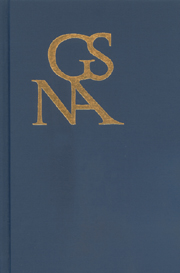Book contents
- Frontmatter
- Contents
- Special Section on Goethe and Idealism
- Introduction—Goethe and Idealism: Points of Intersection
- Goethe and Spinoza: A Reconsideration
- Goethean Intuitions
- Goethe's Notion of an Intuitive Power of Judgment
- “Idealism is nothing but genuine empiricism”: Novalis, Goethe, and the Ideal of Romantic Science
- The Quest for the Seeds of Eternal Growth: Goethe and Humboldt's Presentation of Nature
- Hegel's Faust
- Goethe contra Hegel: The Question of the End of Art
- Goethean Morphology, Hegelian Science: Affinities and Transformations
- Die Gretchenfrage: Goethe and Philosophies of Religion around 1800
- Civic Attachments & Sibling Attractions: The Shadows of Fraternity
- Margarete-Ariadne: Faust's Labyrinth
- Save the Prinz: Schiller's Geisterseher and the Lure of Entertainment
- Walsers Trilogie der Leidenschaft: Eine Analyse seines Goethe-Romans Ein liebender Mann im Kontext der Tradition der Ulrike-Romane
- Review Essay: What's New in the New Economic Criticism
- Book Reviews
Walsers Trilogie der Leidenschaft: Eine Analyse seines Goethe-Romans Ein liebender Mann im Kontext der Tradition der Ulrike-Romane
from Special Section on Goethe and Idealism
Published online by Cambridge University Press: 05 February 2013
- Frontmatter
- Contents
- Special Section on Goethe and Idealism
- Introduction—Goethe and Idealism: Points of Intersection
- Goethe and Spinoza: A Reconsideration
- Goethean Intuitions
- Goethe's Notion of an Intuitive Power of Judgment
- “Idealism is nothing but genuine empiricism”: Novalis, Goethe, and the Ideal of Romantic Science
- The Quest for the Seeds of Eternal Growth: Goethe and Humboldt's Presentation of Nature
- Hegel's Faust
- Goethe contra Hegel: The Question of the End of Art
- Goethean Morphology, Hegelian Science: Affinities and Transformations
- Die Gretchenfrage: Goethe and Philosophies of Religion around 1800
- Civic Attachments & Sibling Attractions: The Shadows of Fraternity
- Margarete-Ariadne: Faust's Labyrinth
- Save the Prinz: Schiller's Geisterseher and the Lure of Entertainment
- Walsers Trilogie der Leidenschaft: Eine Analyse seines Goethe-Romans Ein liebender Mann im Kontext der Tradition der Ulrike-Romane
- Review Essay: What's New in the New Economic Criticism
- Book Reviews
Summary
ANFANG DES JAHRES 2008 veröffentlichte die Frankfurter Allgemeine Zeitung Martin Walsers Goethe-Roman Ein liebender Mann im Vorabdruck. Wie nicht anders zu erwarten bei einem Text, in dem einer der bedeutendsten Schriftsteller der Gegenwart einen Lebensabschnitt des größten deutschen Dichters fiktionalisiert, war das Presse-Echo auf den Vorabdruck und die im März folgende Buchpublikation groß. Die überwiegende Mehrzahl der Rezensionen war außerordentlich positiv, wenn es auch an den gelegentlichen Verrissen nicht fehlte.
In der Zeit vom 21. 2. 2008 schreibt Ulrich Greiner in der ersten größeren Rezension des Romans: “Über diese Affäre [die Goethes mit Ulrike von Levetzow, J. K.] hat Walser jetzt einen seiner schönsten Romane geschrieben” (53). Am 28. 2. 2008 schreibt Thomas Groß im Rheinischen Merkur: “Dieser Altersroman ist auch sprachlich die reifste Leistung des 80 Jahre alten Autors” (21). Joachim Kaiser intensiviert dieses Lob noch, wenn er am 29. 2. 2008 in der Süddeutschen Zeitung schreibt: “Was bei Martin Walser sogleich entzückt, ist die Anmut seiner Schilderung. Man lässt sich bezaubert ein auf Liebes- Passion, Dichter-Gescheitheit, lebendigstes Zeitkolorit. Da übertrifft Walser, sprachmächtig, nicht nur sich selbst, sondern auch so manche berühm te Goetheschilderung der deutschen Literatur” (11).
Selbst einige der vielen positiven Rezensionen jedoch äußern oft leise oder laute Kritik am dritten Teil des Romans. Dafür ist Joachim Kaisers Rezension ein gutes Beispiel. Er schreibt:
Im dritten, abschließenden Teil drängt sich gleichsam ein grimmiger Walserscher Goethe-Essay in den während der ersten beiden Teile so authentisch geglückten Verlauf … Deshalb wirken die Goethe-Briefe an Ulrike, die Walser für den dritten Teil seines Romans imaginierte, seltsam Goethe-fern.(11)
- Type
- Chapter
- Information
- Goethe Yearbook 18 , pp. 259 - 284Publisher: Boydell & BrewerPrint publication year: 2011

